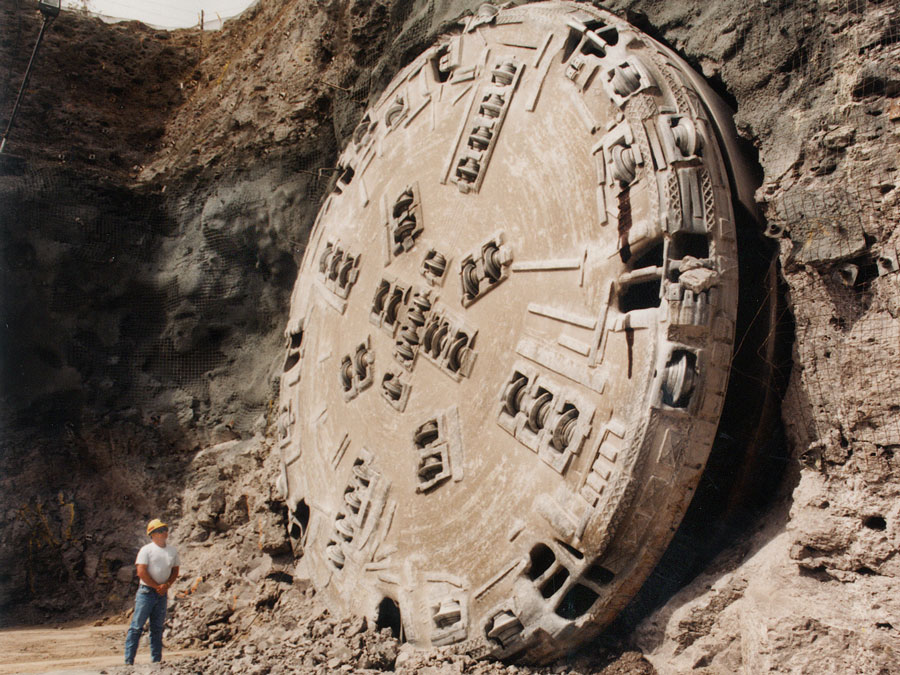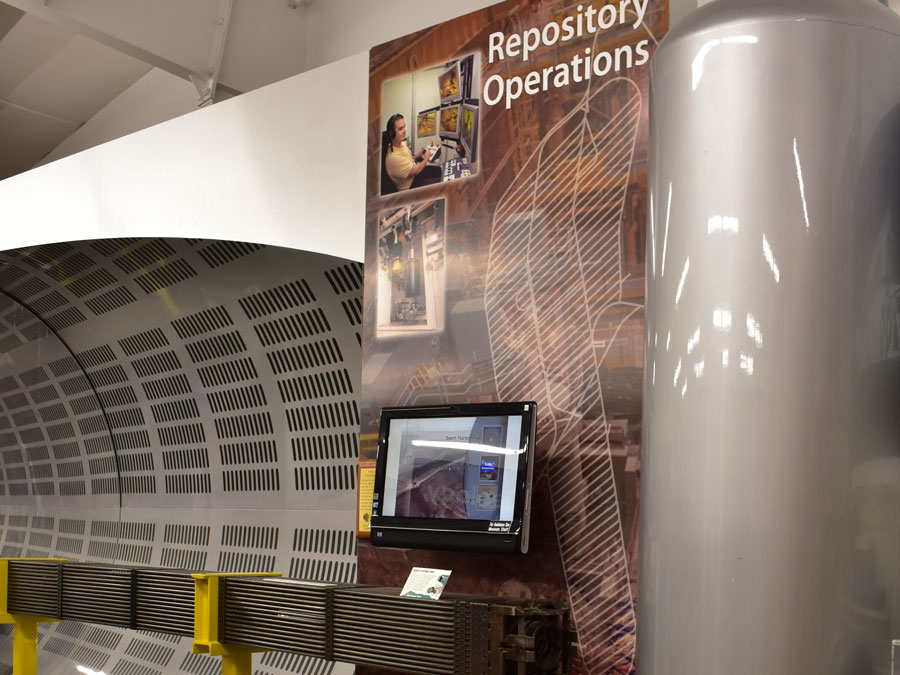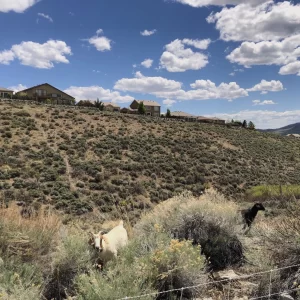
This landscape appears arid. Yet, water flows at the heart of the controversy about a federal plan to build a national nuclear waste repository at Yucca Mountain, in southwestern Nevada. A new scientific paper concludes water is moving through the mountain much faster than researchers previously had suspected. This may increase the possibility that groundwater in the region could become contaminated with radioactive elements.
About 90 miles northwest of Las Vegas, Yucca Mountain originally was designated as a potential nuclear waste storage site in 1983, in part because of its remoteness and its arid clime. With an average of about 6 inches of precipitation yearly, it’s the driest spot in the driest state in the nation.
About 2,000 scientists worked to design more than 60 miles of storage tunnels deep inside the mountain. They researched water movement, seismic activity and corrosion risks to waste containers stored there. They calculated the risks of various possible problems at Yucca Mountain using complex math and assumptions about processes and even about some data. Even back then, they disagreed with each other on many points.
The scientists concluded the the risk of a worst-case scenario — radiation released somehow into the air or getting into groundwater — was on the order of a million-to-one. That’s the figure in the the licensing application now before the U.S. Nuclear Regulatory Commission.
Such an event likely would take thousands of years to occur, said licensed nuclear engineer Charlotta Sanders. She is an associate research professor at the University of Nevada, Las Vegas, and formerly an engineering specialist and group supervisor on the project.
But this latest paper calls that early research on risk into question. The author, geologist Scott Tyler of the University of Nevada, Reno, said water movement models used to calculate those risks are out of date. Measurements taken since then show water is moving much faster than earlier estimates had calculated. The public deserves to feel confident the project would work as designed, he added.
“Yucca Mountain could easily show some contamination in a very short period of time,” added Tyler, perhaps within 100 years.
Tyler reviewed research by dozens of scientists published over the past 25 years. He found that many surprises have popped up regarding water movement within Yucca Mountain. His conclusions were published in January in the journal Geosciences.
“There are so many loose threads,” Tyler said of research at the site. “You pull any one, and it stops the repository, because there are enough uncertainties and questions.”

Cracks in the rock mean water moves faster
In planning out the storage facility’s design, researchers included protections against water seepage. Very little precipitation seeps into the mountain — about 2 inches yearly, on average, according to research. But water that does seep into Yucca Mountain is moving much faster than their designs contemplated, Tyler said.
Researchers discovered this in the 1990s when they tested water that was seeping into an exploratory tunnel drilled at Yucca Mountain. That water contained radioactive chlorine-36, a chemical leftover of nuclear weapons the United States government had exploded in tests nearby starting in the 1950s.
Rain and snow had picked up the radioactive chlorine, then carried it through more than 1,300 feet of rock in less than 50 years. Earlier estimates had predicted such travel would take thousands of years.
Scientists were puzzled. The mountain’s volcanic rock has tiny pores, and their models had predicted water traveling through those pores would only move a few feet per year. So, how had the chlorine-36 moved so far, so fast?
The answer: The rock that makes up Yucca Mountain is full of cracks. Some water, at least some of the time, is traveling down those cracks.
“We knew the rock was fractured, but we didn’t think the water was running down the fractures,” Tyler said. “But now, we find out the water is indeed running right down the fractures.”

Yucca Mountain designed to protect against water
These new findings suggest more water could sit in the rock surrounding the storage tunnels, and actually get into the tunnels, than they were designed to handle, Tyler said.
The repository’s design calls for many layers of steel, concrete and a nickel-zirconium alloy to surround the nuclear waste. These packages protect the waste from water, said nuclear engineer Sanders.
The waste packages would get additional protection from titanium drip shields, stretching over the the packages like umbrellas to prevent water from contacting them.
“It serves as that extra layer against any condensation that could develop in the air surrounding the waste packages, or that could filter through the mountain,” Sanders said.
Some water that gets into the repository’s storage tunnels, however, could become more corrosive, Tyler said. The decaying nuclear waste creates enough heat to boil into vapor any water sitting in the nearby rock. If rock-water were to boil, that would change the water’s chemistry. When the vapor eventually condenses back into liquid and drips into the tunnels, it would be even more corrosive than ordinary water, Tyler said.
Sanders disagreed that the temperature of the spent fuel would be high enough to boil rock-water. “I don’t think it’s that hot,” she said.
Regardless, some water seeping through the rock would condense in the storage tunnels even without boiling heat. Tyler isn’t convinced the titanium umbrellas would keep dripping water off the waste packages underneath: “The drip shield technology is untested,” he said.
And, the repository plan now before the U.S. Nuclear Regulatory Commission doesn’t include drip shields. They would not be added to the repository until potentially 100 years or more, according to a paper published by Nevada Chief Deputy Attorney General Marta Adams.
Without the drip shields, modeling for the repository’s overall system performance “suggests radioactive contamination of groundwater could occur in 100 years or so,” Tyler wrote.
But even in that case, “the release rate on the levels we are talking about are so low,” Sanders said. “We cannot say for sure that would be harmful.” In addition, radioactive materials become less toxic as time goes on, because they decompose, she added.
Nevertheless, “The question becomes, once you find contamination leaking from the canisters, how to contain it or clean it up in a very fractured and high-radiation environment,.” Tyler wrote.

Rise in nuclear waste outpacing storage options
These newly published scientific concerns about Yucca Mountain come as America’s need for a permanent waste disposal site grows each year.
Across the United States, about 20 percent of electricity is generated by nuclear power. The nation has more than 80,000 metric tons created by the nuclear power industry, according to the Government Accounting Office. Yucca Mountains is designed to hold around 70,000 metric tons.
Currently, all that waste is located at 121 temporary sites in 39 states, according to the industry-funded Nuclear Energy Institute (NEI). The technology for storing the spent fuel has advanced, but some of the oldest waste has been held for more than 60 years in casks designed to last 100 years.
While two projects for temporary storage have started recently, the need for permanent storage has some advocating to move forward with plans for the Yucca Mountain repository. Already, the U.S. government has spent $11.4 billion on research, site preparation and licensing, according to a November 2019 report from the Department of Energy’s Office of Inspector General. The next step, a licensing process with the U.S. Nuclear Regulatory Commission, would take at least three more years and cost at least $330 million, according to a November 2017 report by the U.S. Government Accounting Office.
Scientists already have taken enormous precautions to ensure the facility’s safety and reduce risk to something “highly unlikely,” Sanders said. In addition to considering water risks, the project designers factored in earthquakes, volcanic explosions, falling rocks, a rising water table, a wetter climate and a renewed ice age. The risks posed by each scenario are tiny, Sanders said.
“Let’s get Yucca Mountain finalized, complete the licensing review and get it built,” Sanders said. “The alternative is to go back and find another site, start the process all over, and that would cost so much money and delay it even more.”

‘Not just the science’: community concerned
Opponents to the project cite concerns in addition to water contamination, including the right of a state to resist a federally imposed project, possible radiation exposure to sensitive species and the risks of transporting nuclear waste to the site. And members of the Western Shoshone Nation strongly oppose risking contamination of water and land they consider sacred. While some nearby communities have welcomed the economic stimulation the repository would bring, others worry it could dampen tourism.
Seeing all these concerns has taught project scientists important lessons, Sanders said.
“The people of Nevada did not feel they had a voice,” said Sanders, who spent much of her career working on the project. “It’s not just the science. You have to get the public acceptance.”
But the science itself continues to raise more questions than it answers, said Tyler, who conducted his doctoral work as a researcher on the project for the state of Nevada decades ago.
“Scientists originally thought, ‘This is a cool place to put it,'” Tyler said. “But the more we looked at (Yucca Mountain), the more problems we found, and the more fixes it needed.”
It remains unclear, he argued, whether those fixes would be sufficient to protect groundwater beneath Yucca Mountain from nuclear contamination for the next 10,000 years.

Read more about the concerns of the Timbisha Shoshone and the history of the debate over nuclear storage in this comprehensive story on Yucca Mountain, reported by UNR Journalism graduate student Shevawn Von Tobel.





